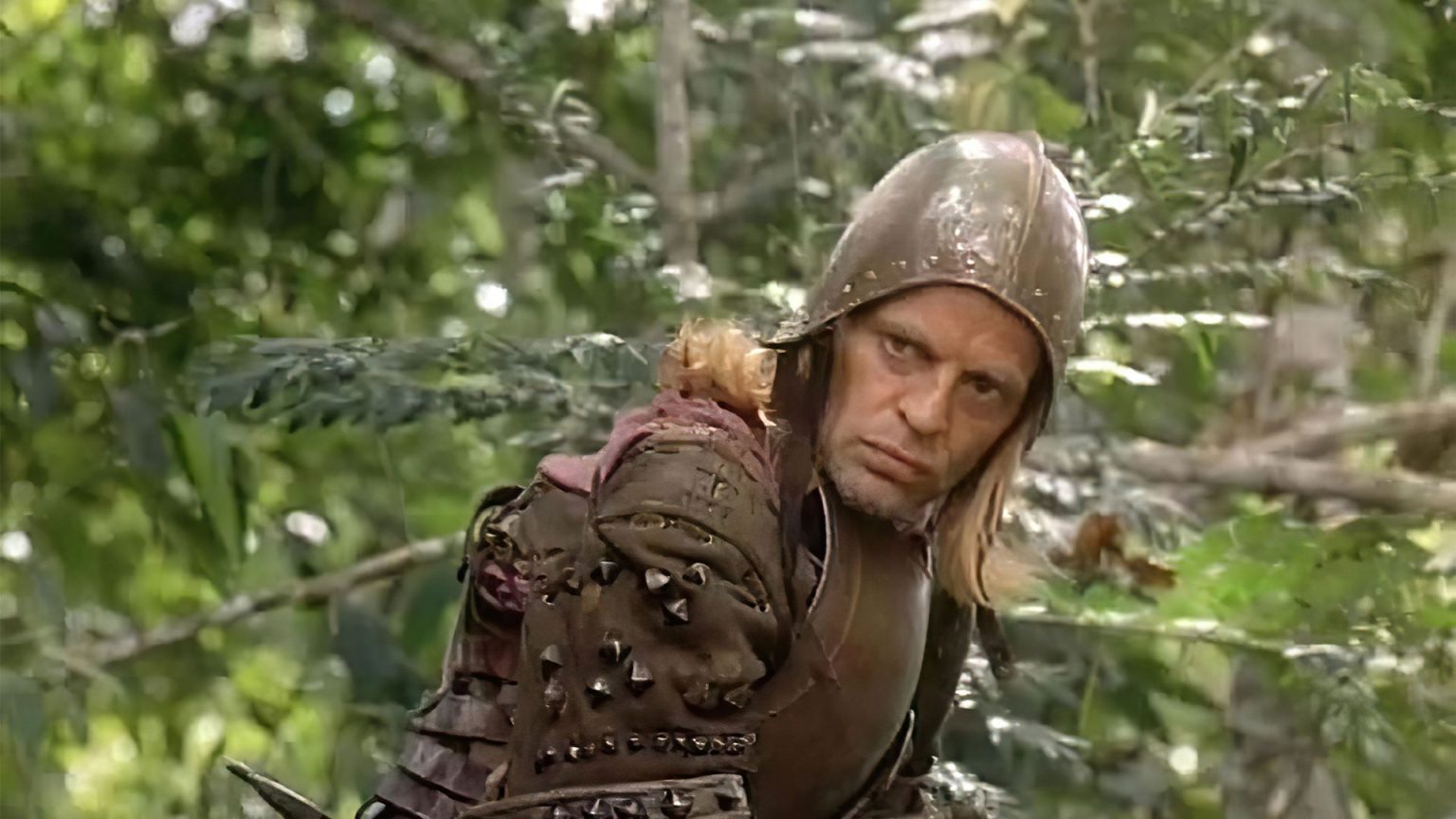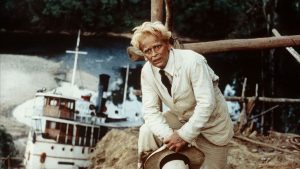Werner Herzog announced himself as a bold, incomparable voice in world cinema with his 1972 feature Aguirre, the Wrath of God, a film that, despite being only the director’s third in an oeuvre now pushing seventy, reflects an already finely-honed aesthetic and philosophical sensibility. It was a series of firsts for Herzog: his first collaboration with infamously temperamental actor Klaus Kinski, his first sojourn through the dark labyrinths of the natural world, and his first work to earn him considerable international recognition and praise. Today, the film functions in part as a cipher for the career it launched, capturing nearly the totality of Herzog’s ongoing preoccupations.
Aguirre is a heavily fictionalized account of the travels of Lope de Aguirre, a treasonous Spanish conquistador who led an expedition through the Amazon to find and capture El Dorado. In the film’s opening text crawl, Herzog immediately dismisses the city as myth, a fabrication thought up by native Incas to deter and ensnare would-be conquerors in the heart of the jungle. With the illusion broken from the jump, Aguirre strips away all pretense of manufactured drama and instead commits to blunt, stark depictions of environmental destruction and violent imperialism.
Many now recognize Herzog primarily for his work in documentary, and though he had yet to direct a nonfiction feature at the time of Aguirre, the formal parallels are clear: his camera is more passive than emphatic, wavering through crowds while crucial events play out in its periphery, often opting to observe subjects rather than center them. The brutality, pettiness, and at times sheer absurdity of his characters and their actions are thus acutely underscored, while the majority of the film’s cinematic spectacle flows naturally from its verdant backdrops. Aguirre was shot on location primarily in the Peruvian rainforest, the overwhelming beauty of which dwarfs human impulse and opens a conduit through which higher powers may intervene with forces seeking to undermine them.
Herzog and Kinski would return to Peru in 1982 for Fitzcarraldo, their fourth collaboration. A dramatization of rubber baron Carlos Fitzcarrald’s historic disassembly and transportation of an entire ship over a mountain, the film had a notoriously troubled production cycle, practically replicating its own narrative in miniature. Endeavouring to portray Fitzcarrald’s struggles as genuinely as possible, Herzog and his crew hauled a real 320-ton steamship through a strenuous patch of dense forest; this mammoth feat, coupled with the jungle’s harsh conditions, led to a great deal of tension on set. (Kinski, already known for his angry outbursts and having clashed with Herzog several times in the past, was reportedly so belligerent that a native chief working as an on-set extra offered to kill him. Herzog politely declined.)
Though Fitzcarraldo wrangles with many of the same themes as Aguirre – plundering of natural resources to the benefit of empire, exploitation of indigenous labor, manic pursuit of a lofty, unattainable goal – the film is primarily concerned with interrogating art’s relationship to human suffering. For the eponymous Fitzcarraldo, the former necessitates the latter: his efforts are all in service of building an extravagant opera house in Iquitos. Initially, this goal seems born from a genuine desire to cultivate appreciation for the artform to which Fitzcarraldo has pledged his life; ultimately, as the baron’s mania eclipses his sentiment, it’s proven to be a solipsistic, fruitless vanity project, undertaken at the expense of the very people whose lives it was supposedly meant to enrich.
Reckoning with the ethical quandaries of Fitzcarraldo is, and always has been, part of the film’s draw. Ever the romantic, Herzog cannot help but relate at least partially to his protagonist’s frenzied passion, and commits many of the same sins: working conditions for the extras, most of them indigenous, deteriorated as production moved deeper into the jungle. Injuries abounded. Relations with Aguaruna tribes soured. A large swath of trees was bulldozed away to make room for the ship. No attempt to scrub away the grisly details of Fitzcarraldo’s production has been made, by Herzog or anyone else (indeed, it was recounted extensively in Les Blank’s on-set documentary Burden of Dreams, released later that same year); the film exists, now, as a contradiction unto itself, as epic, searing, and monumental as it is morally fraught.
The director/actor pair’s fifth and final collaboration came half a decade later, in 1987. Cobra Verde adapts Bruce Chatwin’s The Viceroy of Ouidah, a novel chronicling the life of a fictional Brazilian slave trader who amasses power in several West African coastal territories. Departing radically from the histrionics of Fitzcarraldo, Kinski plays this figure – named Francisco Manoel da Silva – as a calculating, amoral manipulator, coldly surveying his material and geopolitical surroundings, performing silent cost-benefit analyses as he strides through masses of shackled slaves.
Evil has a name in Cobra Verde, and it’s opportunism. Opportunism metastasizes rapidly through the world of the film, seen first on an individual level (da Silva is initially a bandit, only becoming involved in the slave trade when he sees an opportunity to prevent a runaway slave’s escape) and soon after on a societal one. The opportunists are the ones who slither through the cracks of bureaucracy and into positions of immense power, who freely twist the world around their pinky fingers while remaining indifferent to the agony they’ve caused. Cobra Verde, between its occasional bursts of kinetic action, highlights the muted sausage-making behind something so profoundly destructive as the slave trade: an ecosystem of concessions, bargains, and political backstabbing.
The film is easily one of Herzog’s most visually stunning; there’s an increased emphasis on capturing the subtleties of the human face, especially Kinski’s, whose sunken eyes and full, scowling lips betray his quiet and sustained fury. Cobra Verde, as with Aguirre and Fitzcarraldo, was also shot on location, this time largely in Ghana. Herzog mines rich pathos from the landscapes and peoples within, depicting 19th-century Dahomey culture in granular detail and with visual resplendence. He asserts that this culture perseveres overwhelmingly in spite of tyranny, that art, tradition, song, and dance transcend both time and bondage, leaving an indelible mark on the world where despots cannot.






